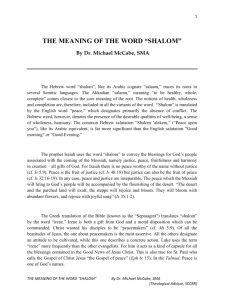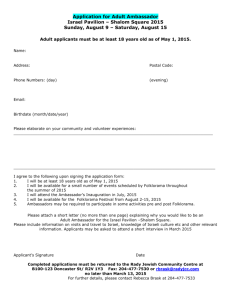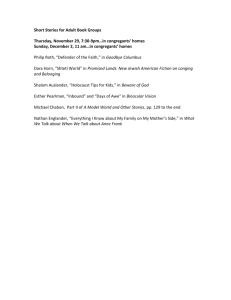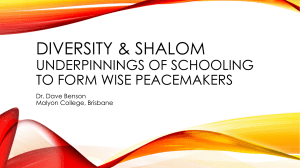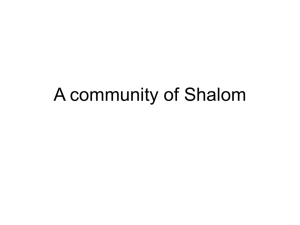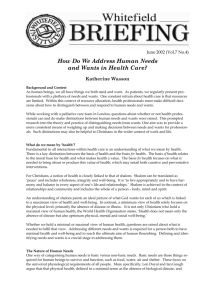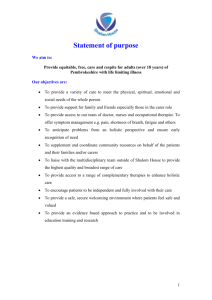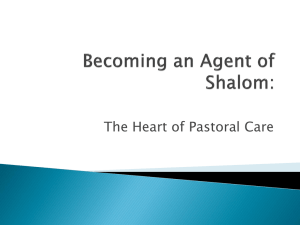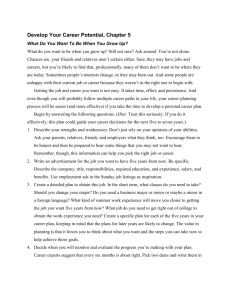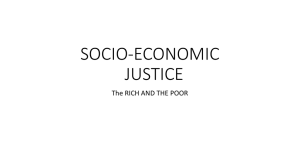BRIEF OUTLINE OF PRESENTATION OF CASE STUDY
advertisement
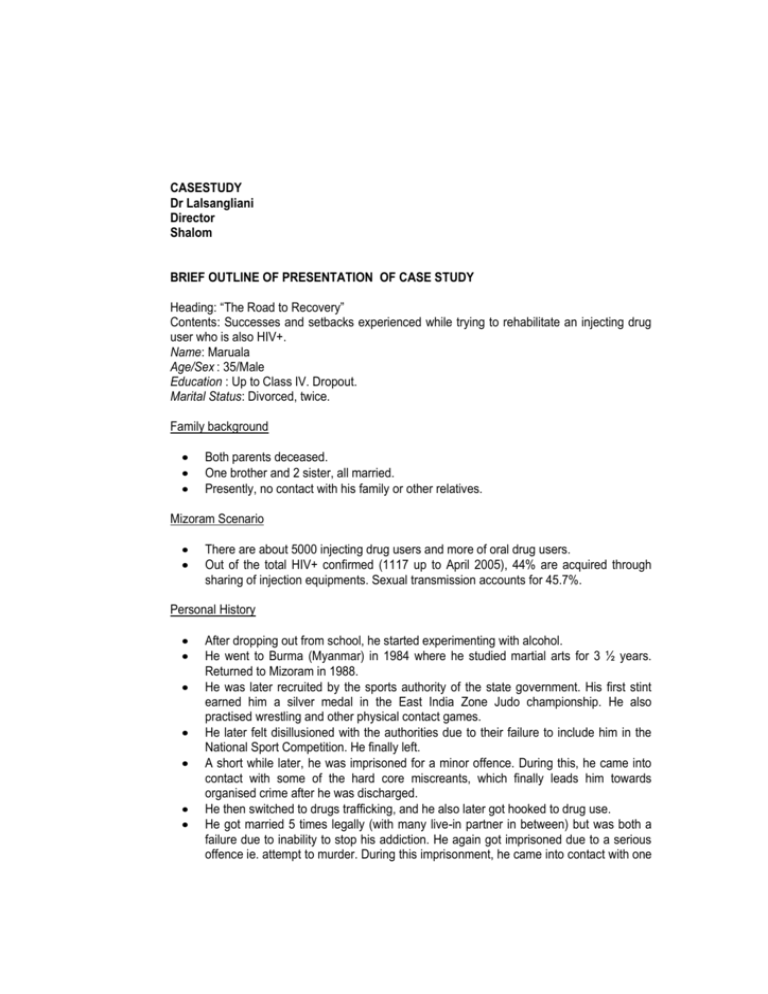
CASESTUDY Dr Lalsangliani Director Shalom BRIEF OUTLINE OF PRESENTATION OF CASE STUDY Heading: “The Road to Recovery” Contents: Successes and setbacks experienced while trying to rehabilitate an injecting drug user who is also HIV+. Name: Maruala Age/Sex : 35/Male Education : Up to Class IV. Dropout. Marital Status: Divorced, twice. Family background Both parents deceased. One brother and 2 sister, all married. Presently, no contact with his family or other relatives. Mizoram Scenario There are about 5000 injecting drug users and more of oral drug users. Out of the total HIV+ confirmed (1117 up to April 2005), 44% are acquired through sharing of injection equipments. Sexual transmission accounts for 45.7%. Personal History After dropping out from school, he started experimenting with alcohol. He went to Burma (Myanmar) in 1984 where he studied martial arts for 3 ½ years. Returned to Mizoram in 1988. He was later recruited by the sports authority of the state government. His first stint earned him a silver medal in the East India Zone Judo championship. He also practised wrestling and other physical contact games. He later felt disillusioned with the authorities due to their failure to include him in the National Sport Competition. He finally left. A short while later, he was imprisoned for a minor offence. During this, he came into contact with some of the hard core miscreants, which finally leads him towards organised crime after he was discharged. He then switched to drugs trafficking, and he also later got hooked to drug use. He got married 5 times legally (with many live-in partner in between) but was both a failure due to inability to stop his addiction. He again got imprisoned due to a serious offence ie. attempt to murder. During this imprisonment, he came into contact with one of his old associate and they started planning on robbing the police malkhana, which housed the arms and ammunitions. They carried out this robbery right after their discharge in the year 2000. They were again caught after 3 weeks. The offence this time was one of the most serious and he was handed a harsh sentence. But apart from all this anti-social behaviours, he maintained an excellent conduct within the prison and received all the possible remissions including the annual good conduct. Contact by SHALOM SHALOM is carrying out the project – Targeted Intervention among Jail Inmates since 2001. Its main focus is on the identification, follow up, support and education of inmates regarding HIV/AIDS and other related hazards. SHALOM came into contact with this case in mid 2001. He was initially indifferent to the services provided by SHALOM, especially the spiritual counselling and guidance services. He had developed a serious negative attitude towards almost everything in life. During all his tribulation, none of his relatives showed any support, not even a single visit. Somehow he was convinced to get his blood tested which unfortunately turned out to be HIV+. This further pushed him towards psychological disturbance and gave up totally on any possible means of rehabilitation. He was discharged after 1 year and 8 months. He went right back to drug use. He found a willing partner who is also into drugs and they both started pushing drugs. They occasionally visited the drop in centre of SHALOM where they were frequently counselled about safe injection and sexual practices. His partner later got her blood tested and it also turned out positive for HIV/AIDS. They were always on the move due to frequent bust by narcotic officials as well as community vigilance networks. They became more and more desperate, and in the meantime, SHALOM counsellors tried to convince them to get themselves admitted in a rehabilitation-cum-detoxification centre. They finally relented and were admitted at AMRO in June 2003. Rehabilitation Process During their detoxification period, they experienced a mental breakdown 2 times with relapses. Finally, he convinced himself to detox without the help of medications. During this time, they were given constant support by SHALOM including daily requirements and monthly fees. They were frequently visited by the counsellors and other staff. They finally became born again Christian and shared their testimonies to many of the community programmes organised by SHALOM and Positive Network of Mizoram (PNM) to which he is an active member. Their troubled pasts leads them to a frequent misunderstandings, and his partner finally left the centre to live with her relatives in October 2004. After this, he maintained an excellent conduct and was finally recruited as a worker by the centre authorities, which he continues to serve till date. He established an excellent rapport with the centre staff as well as the other inmates such that they later gave him charge of financial matters. He was also looking after a piggery farm. He has been an active member of a new network groups among PLWH, namely the Positive Network of Mizoram. He participates in their meetings, seminars and client visit in his free time apart from his duties at the rehab centre. Present Needs As he became more and more involved with the rehabilitation of other inmates, he came to realise that his poor educational background often posed problems. He wants to continue his education but at present, there is no sufficient support system for this particular needs. He is very much interested in mission works and would like to study more of the mission field. Although he would like to again maintain contact with his relatives, he is not presently very enthusiastic, more so because of his seropositive status. Successes The success rate for the recovery and rehabilitation of drug users is very minimal. More so with those who are homeless as well as couples. Out of a staggering 50+ clients who were sent to rehab centres by SHALOM, the achievement (on an average) is a mere 3-5% only. As for those IDU’s who are also seropositive, this is one of the few solid case showing hope for a full recovery and rehabilitation. His eagerness to be accommodated to the society as well as the church institution is also another major success. Many of the recovering drug users continues to dissociate themselves from the community and the church, which in turn makes them prone for relapse. The whole rehab process has taught him an important lesson of self sufficiency and self reliance. He is able to save his monthly earnings, although meagre it may be, and is shelling out some of it too for some of the poor homeless inmates at the centre. He has discovered the joy of Christian worship and devotion. He devotes a major chunk of his time for communion with the Lord. Responses and Interventions by Churches Contrary to what many had hoped, the church, like a sleeping giant, is slowly waking up to this urgent call. One of the main reason could be that it has many a times utilised its resources without any professional help and guidance (and as such, with unscientific approaches) for the recovery and rehabilitation of drug users. This frequently results in failures which in turn produces negative attitudes. Even then, SHALOM, through its advocacy campaigns among church groups, has incessantly addressed the problems faced by the drug user community and their varied needs. Within the last 1 year, a number of volunteers were entertained from the church groups and youth groups; who rendered innumerable help (see pictures). Worship and prayer meetings were held and the plight of our clients (including the ones under study) were presented. We commonly receive donations and contributions in the form of materials as well as monetary. The case in study were in particular a constant prayer topics in some of the church groups which resides within our target areas. Some of the youth groups has shown positive interest and hope is on that the case in study may receive support from these groups. Obstacles Personal Level : 1.Temper tantrums 2.Violent behaviours – which is a common occurrence among drug users couples. 3.Recurrent rebel behaviour towards the establishment. 4.Suspicions/jealousy towards their partners. Family : He has encountered a long history of negligence, abuse and discrimination even from their relatives. There is a general feeling of uselessness which in turn develops into a negative attitudes towards his families/relatives. This poses problems as family placement is one of the most important factor/criteria for his recovery. Society : He has experienced numerous stigmatisation and discrimination from the society, even sometimes imprisonment and physical abuse. He also has numerous negative encounters from the law enforcers too. Spiritual : He has experimented with various methods but without any accompanying psycho-social counselling, which leads them to a state of spiritual numbness. Fortunately, he found peace and solace when least expected. Methods Employed to Overcome Obstacles Concentrate on psycho-social counselling : Apart from the counselling received at the centre, he is frequently visited by our counsellors, ORW’s and sometimes the doctors and nurses. Human touch – visits on special occasions with gifts and presents (eg. Christmas etc) Physically – Any of his health problems were instantly addressed; through visits by doctors or referrals to other centers/hospitals. Sustenance – Enquiries were made to govt. agencies as well as other institution about possible means for his future establishment. The excellent networking with these centres and agencies has been a big help. Society placement – The need for advocacy has been addressed. He is keen to be reinstituted in the society as well as in the church group. His social needs are keenly observed. Spiritual Guidance – Apart from the spiritual gatherings, worship and devotion programmes at the centre, he has been a constant topic in our prayers. He also frequently participated in the devotion programmes of SHALOM. KEY LESSONS LEARNT Holistic Approach – We have been exposed to a wide range of issues that are required for the rehabilitation of stigmatised groups, personal to society levels. It’s a matter of changing one’s life – nothing is trivial. The importance of family and its impact on individuals has been fully explained on this particular case. The importance of social structure, rights of individuals has been thoroughly learned. The need for institutions that can render specific services have been clearly identified. The impact of church in an individual’s life and the inadequacy experienced can be one of the key lessons. Building and strengthening networks with like-minded organisations and societies including govt. officials is one key point noted here. You just can’t do it alone! THANK YOU

